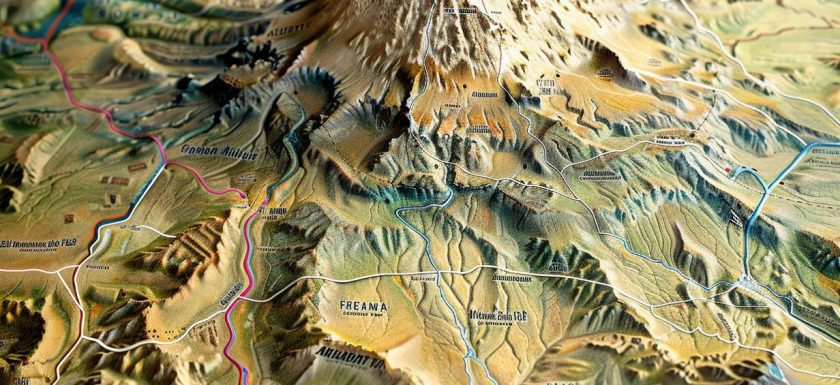
Thinking about climbing Kilimanjaro? With so many routes to choose from, it can be overwhelming to decide which one is right for you. From the popular Marangu Route to the challenging Umbwe Route, each option offers a unique experience.
This guide will explore the different routes, factors to consider when choosing a route, duration of each route, highlights, and challenges. Whether you’re looking for breathtaking views or a less crowded path, we’ve got you covered. Let’s dive into the world of Kilimanjaro routes!
Key Takeaways:
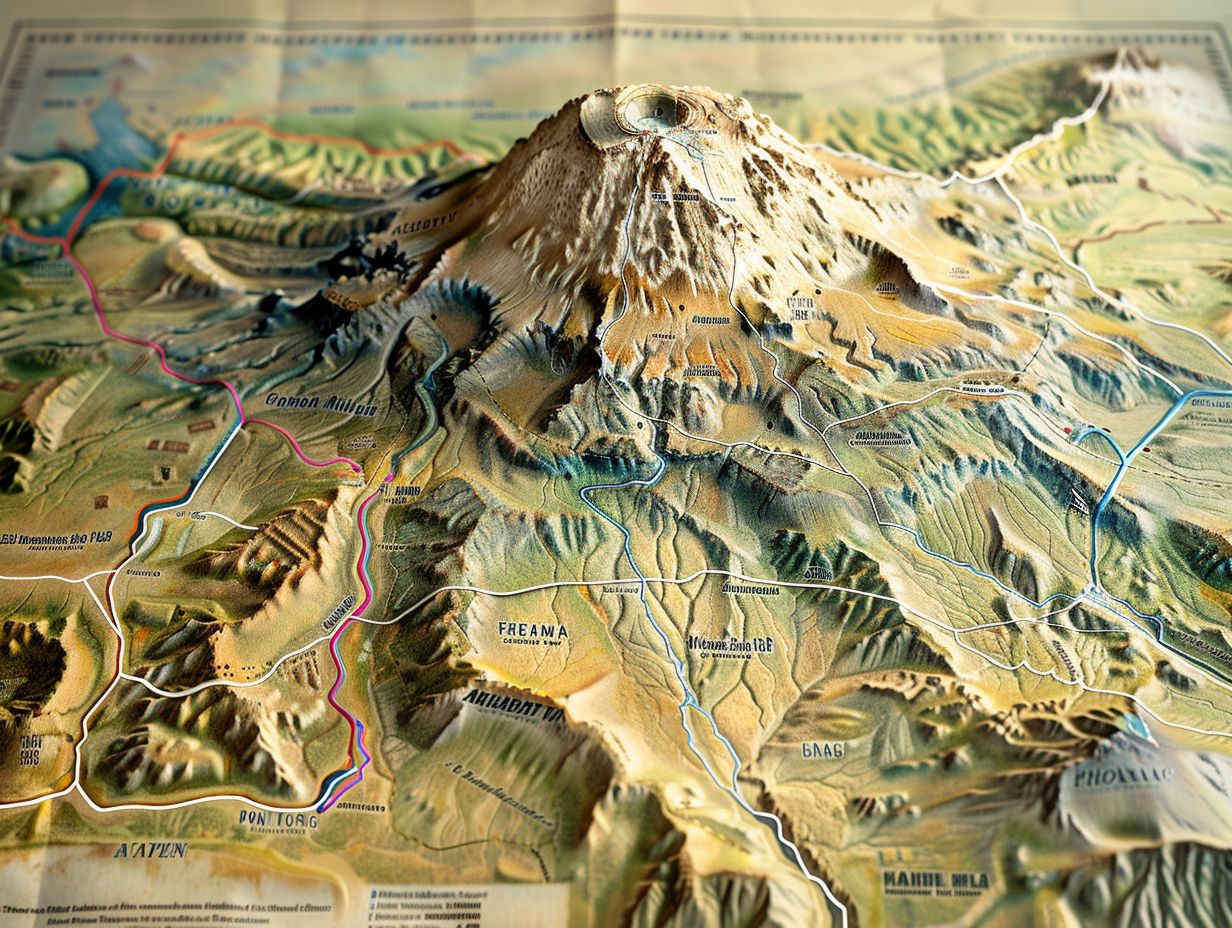
- 1. There are 6 routes to climb Kilimanjaro, each with its own unique features and challenges.
- 2. When choosing a route, consider factors such as difficulty level, scenery, crowds, accommodation, and cost.
- 3. The duration of each route varies, with the Marangu route being the shortest and the Northern Circuit route being the longest.
What Are the Different Routes to Climb Kilimanjaro?
Mount Kilimanjaro offers several routes for climbers to reach its summit, each with unique challenges and experiences. The main routes include the Marangu Route, Machame Route, Umbwe Route, Rongai Route, Shira Route, Lemosho Route, and the Northern Circuit Route.
Among these routes, the Marangu Route, also known as the Coca-Cola Route, is one of the most popular paths due to its gradual ascent and huts for accommodation.
Contrastingly, the Machame Route, often dubbed the Whiskey Route, is frequented for its stunning scenery and diverse landscapes but poses a higher level of difficulty.
The Umbwe Route is renowned for its steep and direct climb, appealing to more experienced climbers seeking a challenging adventure.
The Rongai Route offers a more gradual slope, passing through both rainforest and alpine desert.
On the other hand, the Shira Route and Lemosho Route provide a scenic wilderness experience with varying terrains.
The Northern Circuit Route is the longest and less crowded option, perfect for those wanting a more secluded journey.
Marangu Route
The Marangu Route, also known as the ‘Coca-Cola Route’, is one of the most popular paths up Kilimanjaro due to its gradual slope and hut accommodations along the way.
Historically, the Marangu Route gained its nickname due to the availability of Coca-Cola at the huts along the trail, adding a touch of comfort to the challenging trekking experience. The route’s huts provide trekkers with a cozy and safe resting place, equipped with bunk beds, dining areas, and even gift shops.
This makes it a favorable choice for those seeking a more comfortable trekking option compared to camping. The success rate on the Marangu Route is relatively high, attributed to the gradual ascent profile, allowing for better acclimatization, and hence increasing the chances of reaching the summit.
Machame Route
The Machame Route, often called the ‘Whiskey Route,’ is a popular choice for climbers seeking a more challenging and scenic ascent through diverse vegetation zones.
The Machame Route offers a variety of camping options, allowing trekkers to immerse themselves in the stunning surroundings of Kilimanjaro. From lush rainforests to alpine desert landscapes, each campsite provides a unique experience. One of the highlights is the Shira Camp, known for its breathtaking views of the Shira Plateau.
- The natural beauty along the route is unparalleled, with rich flora and fauna adding to the allure of the journey. As climbers make their way through tropical rainforests, they are greeted by a diverse array of plants and wildlife, creating a truly immersive experience.
- For those seeking a challenging climb, the Barranco Wall is a thrilling highlight. This steep rock face presents a demanding yet rewarding opportunity for climbers to test their skills and enjoy panoramic views of the mountain.
- The trek up Kilimanjaro’s Machame Route is not just about reaching the summit, but also about the journey itself. With its varied landscapes, camping options, and adventurous challenges, this route offers a truly unforgettable experience for those seeking the ultimate trekking adventure.
Lemosho Route
The Lemosho Route is a longer and more remote path up Kilimanjaro, known for its stunning scenery, diverse altitudes, and higher success rates due to better acclimatization.
With a gradual ascent over seven to nine days, the Lemosho Route offers trekkers a chance to acclimatize effectively, reducing the risk of altitude sickness. This extended duration allows adventurers to adjust to increasing altitudes, maximizing their chances of reaching the summit.
The varying landscapes encountered along the route, from lush rainforests to alpine deserts, provide a unique and unforgettable experience. Despite unpredictable weather conditions, such as sudden changes in temperature and occasional rainfall, proper preparation and a well-equipped team enhance the overall trekking experience.
Rongai Route
The Rongai Route offers a less crowded and more gradual approach to Kilimanjaro, showcasing unique geological features such as volcanic cones and stunning views along the way.
One of the notable volcanic cones along the Rongai Route is Mawenzi, part of the Kilimanjaro massif, providing a breathtaking backdrop for climbers. The route’s path also allows trekkers to witness the intricate geological formations of ancient lava flows, adding a sense of wonder to the journey.
As you ascend, the landscape transitions from lush rainforest to alpine desert, revealing the diverse ecosystems that make Kilimanjaro such a unique climbing experience. This transition in vegetation and terrain makes every step of the climb a captivating adventure.
Northern Circuit Route
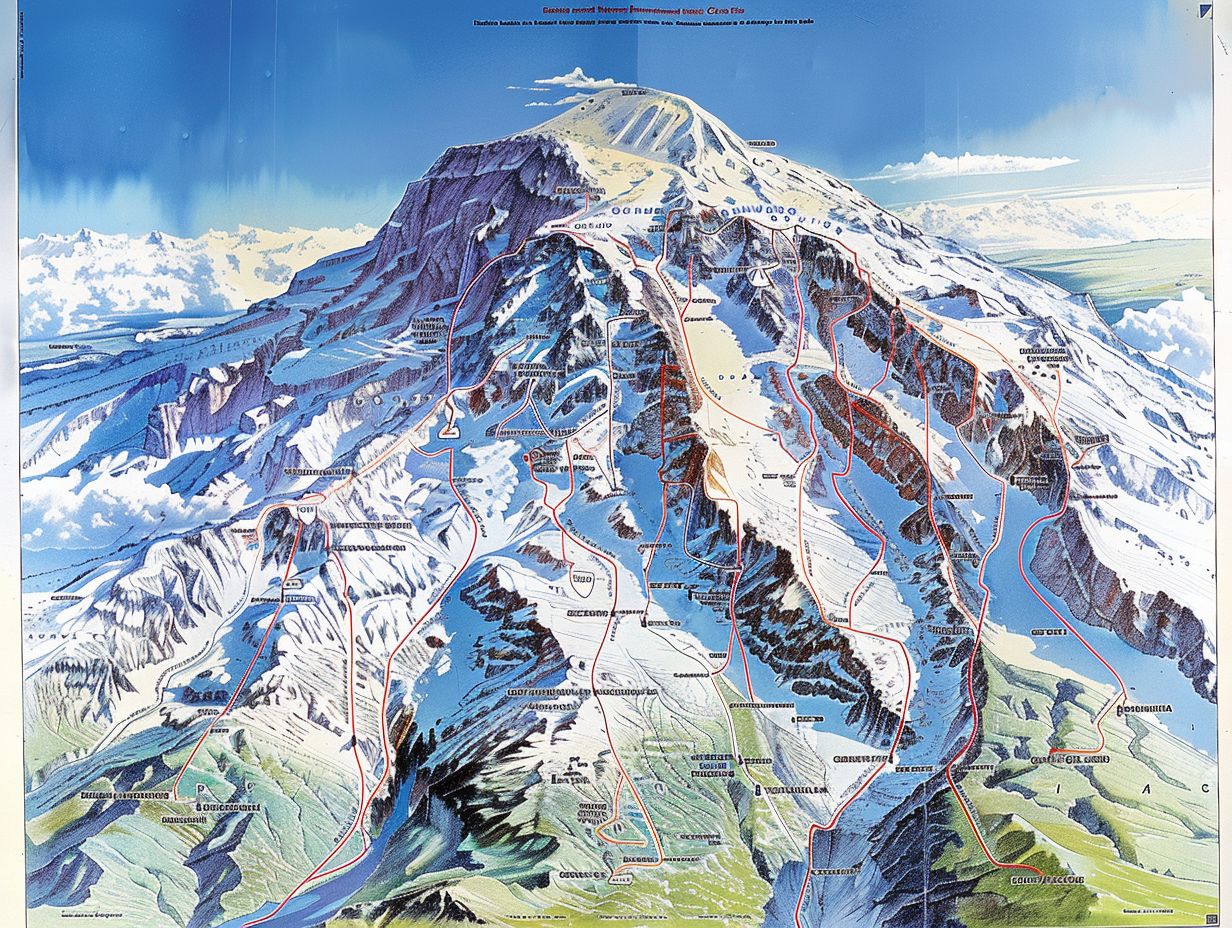
The Northern Circuit Route is the longest path up Kilimanjaro, known for its high success rates and panoramic views, including diverse landscapes such as forests and descent routes.
One of the unique features of the Northern Circuit Route is its success rates in helping trekkers reach the summit of Kilimanjaro. This route offers a more gradual ascent, allowing for better acclimatization and thus contributing to higher success rates among climbers.
The scenic diversity along the path is breathtaking, with lush forests transforming into rocky terrains and snow-capped peaks in the distance.
The descent routes through forests present their own set of challenges. Navigating through dense vegetation requires focus and careful footing, adding an element of adventure to the trek. Yet, the reward of witnessing the rich biodiversity of the mountain’s forest ecosystems is unparalleled.
Umbwe Route
The Umbwe Route is the steepest and most direct route to Kilimanjaro’s summit, attracting climbers seeking a challenging ascent and physical achievements
Which Route is the Best for You?
Choosing the best route to climb Kilimanjaro depends on various factors such as your climbing experience, physical fitness, preferences for scenery, and desired level of challenge.
For those with limited experience, the Marangu route, also known as the ‘Tourist Route,’ with its gradual slopes and hut accommodations, could be a suitable choice. On the other hand, seasoned climbers might prefer the Machame route, renowned for its stunning views and varied terrain.
Acclimatization needs should also be considered, making the Lemosho route ideal for a slower ascent. Those aiming for a high success rate might opt for the Rongai route, known for its gentle slopes and less crowded paths.
What Are the Factors to Consider When Choosing a Route?
When deciding on a route to climb Kilimanjaro, it’s essential to consider factors like the difficulty level of the route, the scenic views it offers, accommodation options available, crowd levels, and the overall cost and duration of the climb.
The difficulty level of the route plays a significant role in determining the climbing experience. Some routes are more challenging, requiring higher levels of physical fitness and technical skills, while others are more suitable for beginners or less experienced climbers. The choice of route can greatly impact the success and enjoyment of the climb.
The scenic views along the route can vary significantly, offering diverse landscapes and breathtaking panoramas. Some routes are known for their stunning sunrises or sunsets, while others traverse through lush forests or rocky terrain, providing a unique visual experience at every turn.
Accommodation options on different routes range from basic campsites to luxury lodges. Deciding on the level of comfort and amenities you prefer during the climb is essential to ensure a comfortable and enjoyable experience.
Difficulty Level
The difficulty level of a Kilimanjaro route is influenced by various factors like altitude, terrain conditions, and the technical skills required, making it crucial for climbers to assess their experience and fitness level before choosing a route.
Altitude plays a significant role in the challenge level of a climb, as the higher you ascend, the thinner the air becomes, impacting breathing and overall physical performance.
Terrain conditions, ranging from rocky paths to icy slopes, add an element of unpredictability and necessary adaptability. Technical skills, such as using ropes or navigating crevasses, can be essential in certain routes and require a higher level of expertise.
Scenery and Views
The scenic beauty and panoramic views along a Kilimanjaro route play a significant role in enhancing the climbing experience, with each path offering unique landscapes, from lush forests to volcanic formations.
One of the most captivating aspects of the Kilimanjaro routes is the transition from verdant rainforests at lower altitudes to alpine deserts as climbers ascend higher. The vibrant colors of exotic flowers and the calls of various bird species create a magical atmosphere in the lower zones.
Ascending further, trekkers are greeted by rugged terrain marked by ancient lava flows, adding a mysterious touch to the journey. The diverse flora and occasional sightings of wildlife like colobus monkeys or antelopes make the experience even more enriching.
Crowds and Traffic
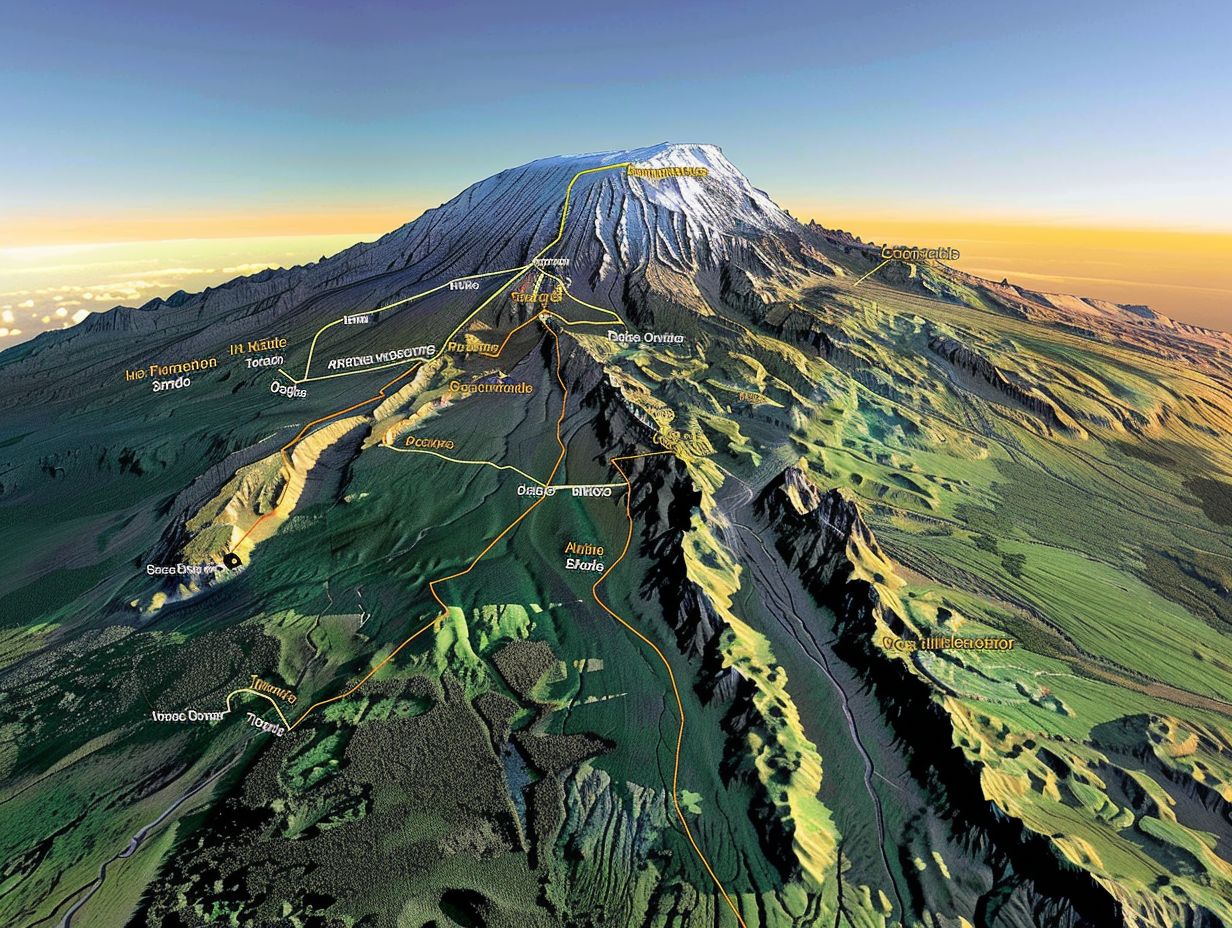
Crowd levels and traffic congestion can significantly impact the climbing experience on Kilimanjaro, with some routes being more popular and crowded than others, affecting the solitude and pace of the ascent.
For those seeking a more solitary journey, opting for quieter routes such as the Lemosho or Northern Circuit may offer a more serene experience amidst the stunning landscapes. On the other hand, climbers looking for a more social atmosphere may prefer the bustling trails of the Machame or Marangu routes, where interaction with fellow climbers is more common.
Understanding these crowd dynamics is crucial in tailoring one’s climbing experience to match their desired level of solitude and social engagement.
Accommodation Options
The availability of accommodation options, including camping sites, huts, or lodges, along the Kilimanjaro routes is a key consideration for climbers planning their ascent, as it impacts comfort, rest, and overall trekking experience.
Routes on Kilimanjaro offer a range of accommodation choices catering to diverse preferences. The camping sites provide a rugged yet immersive experience in the heart of nature, with climbers setting up tents amidst the breathtaking surroundings. Huts along the paths offer a more sheltered option, often equipped with basic amenities like bunk beds and shared facilities for a communal living experience.
Cost and Duration
Cost and duration are vital factors to consider when selecting a Kilimanjaro route, as different paths vary in terms of expedition length, permit fees, guide services, equipment rentals, and overall affordability.
When assessing the financial implications, climbers must account for the costs of park fees, which can range from $60 to $100 per day, depending on the route chosen.
The expense of hiring experienced guides and porters is a necessary investment for ensuring a safe and successful climb. Equipment rentals, such as sleeping bags, trekking poles, and proper clothing, also contribute to the overall budget.
Planning and budgeting effectively is crucial to avoid unexpected expenses and ensure a smooth trekking experience.
How Long Does Each Route Take to Climb?
The duration of each Kilimanjaro route varies depending on the distance, altitude gain, acclimatization schedule, and overall trekking pace, with routes spanning from 5 to 9 days on average to reach the summit.
For instance, the Marangu route, known as the ‘Coca-Cola route,’ takes about 5-6 days for the ascent, typically with a longer descent period due to the same path. Meanwhile, the Lemosho route, offering more gradual acclimatization, usually extends over 7-9 days, allowing climbers to adjust better to higher altitudes.
Acclimatisation play a crucial role in preventing altitude sickness, with most routes incorporating multiple stops at strategically placed campsites to enhance climbers’ adaptation to the elevation.
What Are the Highlights of Each Route?
Each Kilimanjaro route offers unique highlights and landmarks, from breathtaking viewpoints and diverse ecosystems to iconic geographical features like volcanic cones and glaciers, enriching climbers’ experiences and memories.
For instance, the Marangu route, also known as the ‘Coca-Cola’ route, stands out for its scenic beauty with lush rainforests and awe-inspiring views of Mawenzi and Kibo peaks.
In contrast, the Machame route, often dubbed the ‘Whiskey’ route, is renowned for its varied terrain, passing through heath and moorland zones before reaching the snow-capped summit.
The Lemosho route, considered one of the most picturesque paths, offers a sense of solitude and tranquility as it winds through pristine wilderness and provides panoramic vistas of the Kilimanjaro massif.
What Are the Challenges on Each Route?
Climbing Kilimanjaro presents unique challenges on each route, including altitude sickness, extreme weather conditions, physical exertion, and technical obstacles, testing climbers’ resilience and determination throughout the ascent.
Altitude sickness, one of the most common hurdles, can strike even the fittest climbers as they ascend the mountain. Symptoms such as headaches, nausea, and fatigue can hamper progress and threaten success.
To combat this, climbers are advised to properly acclimatize by ascending gradually and taking rest days to help their bodies adjust to the altitude.
Weather fluctuations, ranging from scorching sun to freezing temperatures, require climbers to be prepared with suitable gear and clothing to stay safe and comfortable along the journey.
Frequently Asked Questions
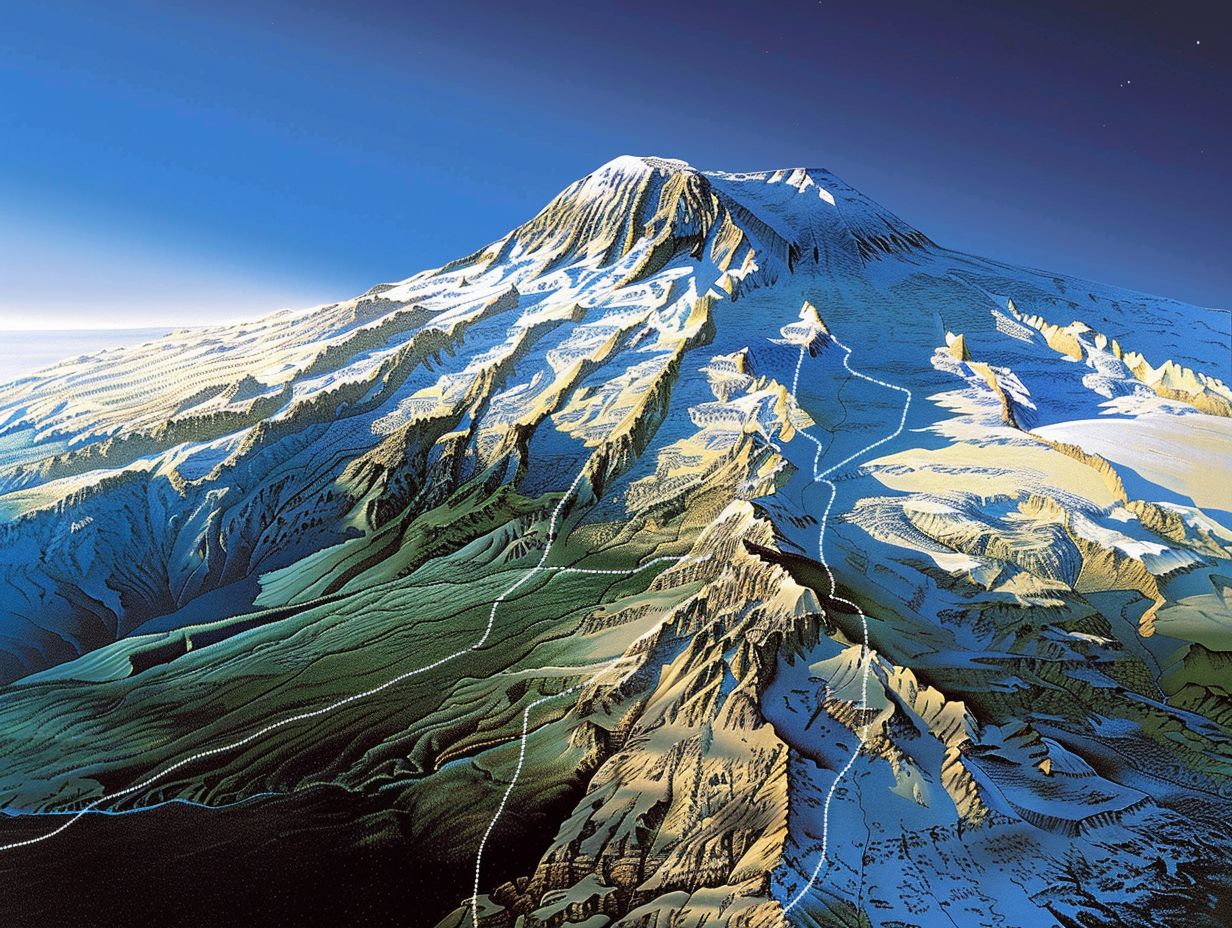
1. What is a Kilimanjaro Route Map?
A Kilimanjaro Route Map is a detailed illustration of the different trails and paths that lead to the summit of Mount Kilimanjaro, the highest mountain in Africa. It includes important landmarks, campsites, and elevation changes along the way.
2. Why is it important to have a Kilimanjaro Route Map?
Hiking Mount Kilimanjaro is a challenging and strenuous journey, and having a route map can help ensure you stay on the correct path and reach your destination safely. It also helps you plan and prepare for your trek, knowing the distance and difficulty of each route.
3. Where can I find a Kilimanjaro Route Map?
You can find Kilimanjaro Route Maps online, in guidebooks, or from tour companies that offer trekking packages. It is important to make sure the map is up-to-date and accurate before using it for your journey.
4. How many routes are there on the Kilimanjaro Route Map?
There are seven main routes on the Kilimanjaro Route Map: Marangu, Machame, Lemosho, Shira, Rongai, Northern Circuit, and Umbwe. Each route offers a different experience and level of difficulty, but they all lead to the summit.
5. What is the most popular route on the Kilimanjaro Route Map?
The Machame Route is the most popular route on the Kilimanjaro Route Map, known for its spectacular views and varied terrain. It is also one of the longer routes, giving hikers more time to acclimate to the high altitude.
6. Can I create my own route on the Kilimanjaro Route Map?
It is not recommended to create your own route on the Kilimanjaro Route Map, as the mountain is a protected area and all hikers must follow designated paths. Straying from the designated routes can also be dangerous, as certain areas may be unstable or prone to rockfalls.